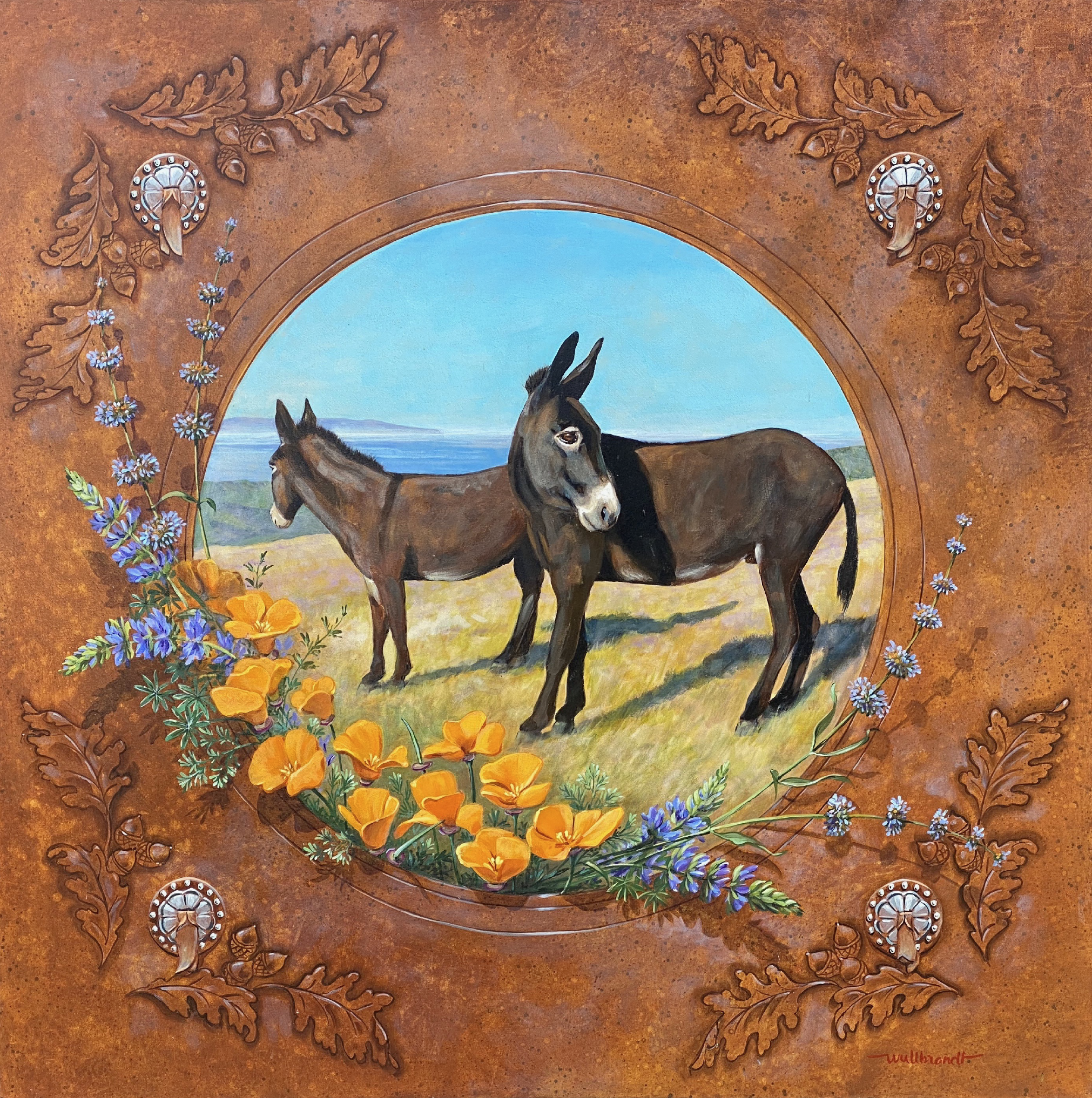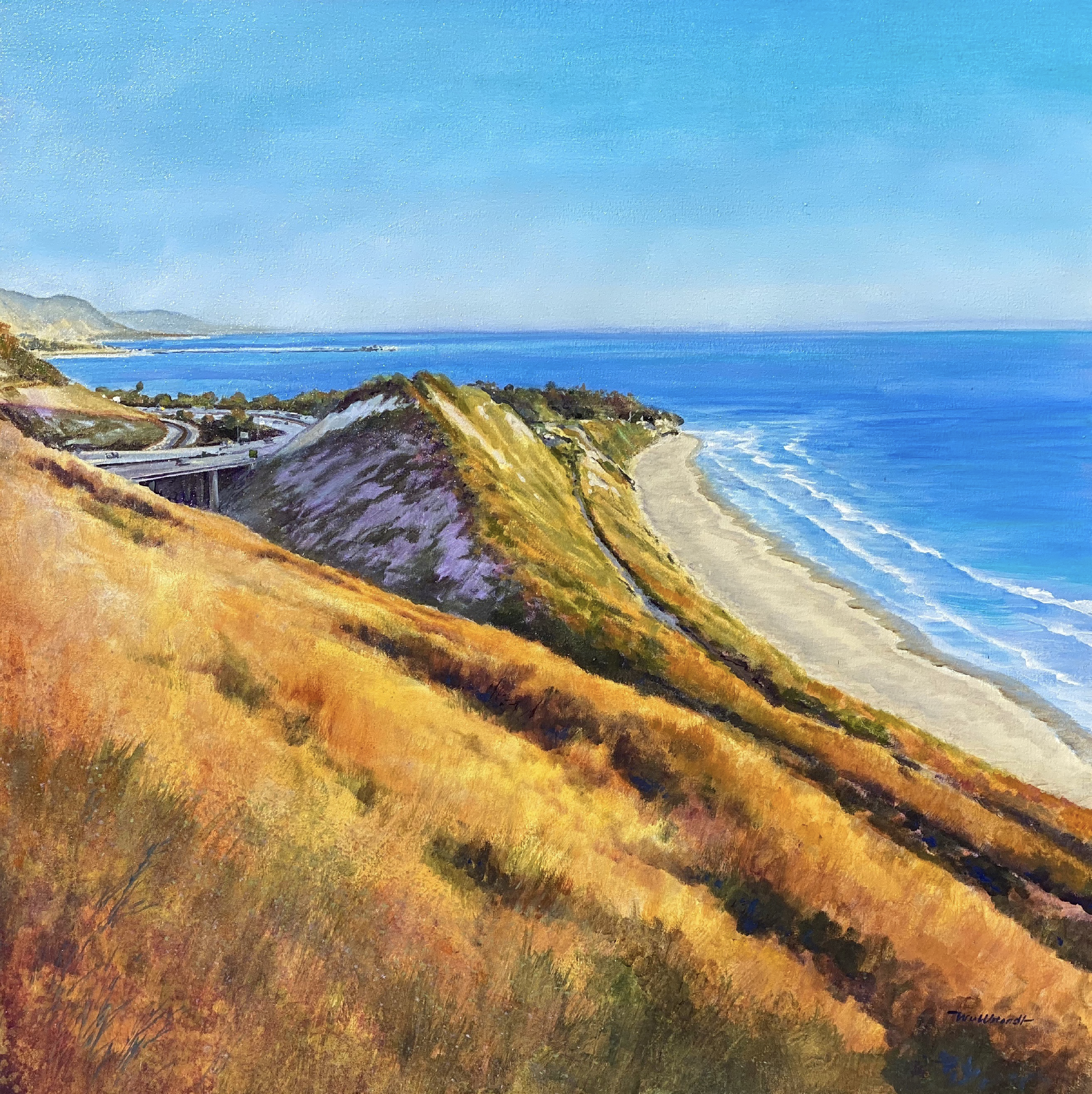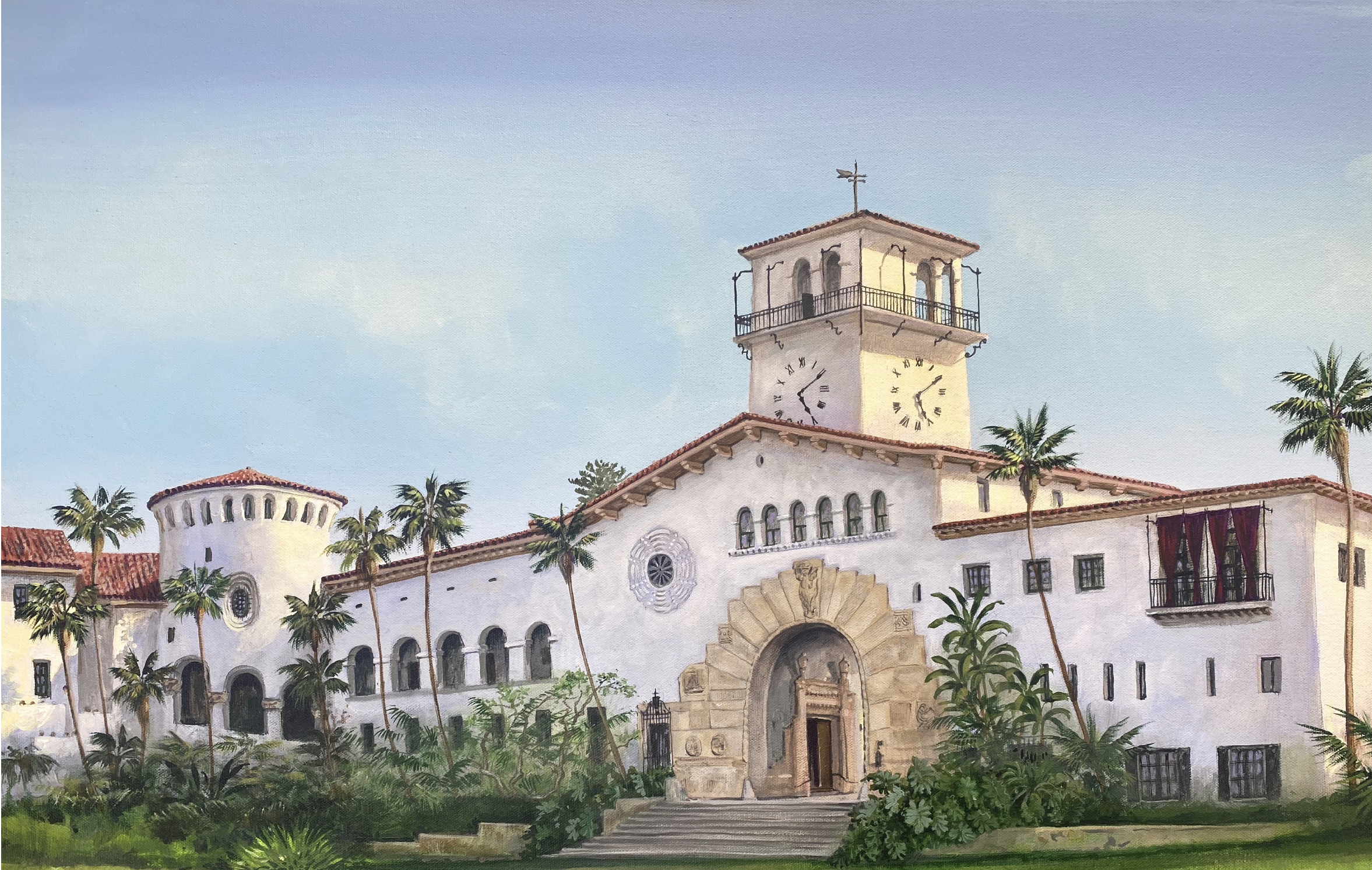John Wullbrandt/2021 a Retrospective at Santa Barbara Fine Art Gallery
By Christine Hsu, Lum x UCSB arts writing intern
John Wullbrandt’s retrospective exhibition, John Wullbrandt/2021, at Santa Barbara Fine Art Gallery, is a gorgeous, sun-kissed selection of his paintings, exploring Santa Barbara County’s many splendors – from landscapes and pastoral vignettes to urban and architectural portraits. Across the exhibition, his technical mastery is on display, featuring the places, mementos and monuments that are near and dear to the Chismahoo, Carpinteria artist.
Born and raised in Carpinteria, Wullbrandt’s passion for art began at a young age. As a teenager and young person, he often visited the Santa Barbara Museum of Art and studied art history at Santa Barbara City College, where he painted with Robert Frame and drew with Kenneth Nack.
John Wullbrandt, Bluffs to Rincon Point, acrylics on canvas
John Wullbrandt, Barn at Sedgwick Reserve, acrylics on canvas
In Morning on Stearns Wharf, Santa Barbara, Wullbrandt recaptures a serene moment from his time at SBCC. “I drew the same view from approximately the same spot in pen and ink 50 years ago,” said Wullbrandt. “By recreating this drawing, I was able to go back to my days at Santa Barbara City College.”
In the late 70s, Wullbrandt moved to San Francisco where he opened his own studio and took on mural work. While creating a large exterior mural for the city, Wullbrandt pioneered liquid silicone paint, commonly used in the East Coast but not as much on the West Coast. The technique offered additional protection to the mural, allowing it to withstand harsh weather conditions.
The meaning behind the mural reflected an equally strong message: a building rising from the rubble of another building. “The mural was keeping with San Francisco’s model of the phoenix rising from the ashes,” said Wullbrandt. “It’s an illusion within an illusion.”
John Wullbrandt, Morning at Maclovio Falls, acrylics on canvas
In 2002, Wullbrandt decided to move back to his ranch in the hills of Carpinteria where his ancestors homesteaded. Morning at Maclovio Falls showcases Wullbrandt’s favorite place on the ranch. To create this piece, he used a technique of adding three to four layers and then pulling back the paint to create the shapes of the rocks, bark and water. He then added glazes, highlights and shadows.
“When I was little I did not know this place existed, because I only went where the cattle went,” said Wullbrandt. “Since I discovered Maclovio Falls, I have gone down to draw and paint.”
John Wullbrandt, Sunset on La Granada Mountain, acrylics on canvas
Sunset on La Granada Mountain depicts a female cow Wullbrandt raised from a calf and the beautiful landscape only steps away from his painting studio. Before he began to paint, Wullbrandt studied the moment, steps away from the calf. “I threw her a flake of hay, took a step back, and really looked at her,” said Wullbrandt. “I thought about the color of the shadows and the particular shade of red that goes across her hide.”
In this realistic painting, Wullbrandt emphasizes the strong shadow from the horn. Even though the shape of the shadow is quite peculiar, the viewer can identify the shape of the ear, the weight of the cow, and the location of where the sun is located.
John Wullbrandt, 3 Cows, acrylics on canvas
John Wullbrandt, End of the Day, acrylics on canvas
In 3 Cows and End of the Day, Wullbrandt continues to share and capture his life on the ranch, and his days out in nature, with his wonderful animals. To start these paintings, Wullbrandt approaches the canvas knowing what colors he will add for each layer and for the background. He paints the initial layer and then blocks off portions with the following layers.
When bringing out the shapes and texture of grass, he combines the two techniques of pulling off paint and painting in wisps of grass. The shadows underneath the cows, and the background colors behind the cows, evoke the natural appearance of standing. “I am really fond of these paintings because they represent a part of my life, and I get to share this location with these wonderful animals,” said Wullbrandt. “I used to run cattle, but now they are my pets.”
John Wullbrandt, On Target, acrylic on canvas
The acrylic painting, On Target, is biographical and allegorical of real objects from Wullbrandt’s life. To make the two feathers appear natural, Wullbrandt referenced real feathers that he found on his ranch and applied glazing and dry brush techniques. He also captured the exact shape and size of the dart board, the metal numbers and the pitchfork by tracing the objects onto the canvas.
For the barn stall door, Wullbrandt created a faux bois look with the wood. The four boards that create the background have a graining look, achieved with dark shadows and bright highlights. On the far-right board, there is a large crack that runs down the middle. “The crack has a slight curve to it with the grain,” said Wullbrandt. “That crack really helps make the grain and wood look realistic.”
Other objects, commonly found on a barn stall door, are seen surrounding the dart board: a triangle, a hay hook and a horseshoe. “The horseshoe was fun to paint because it is flat and it has no dimension,” said Wullbrandt. “It is a symbol of good luck, which brings a warm fuzzy feeling to the painting, and it helps this painting appear less threatening.”
The most important feature of this painting is the way it performs as a trompe l'oeil. Underneath the horseshoe are the words: Stand Back 7’9”, which Wullbrandt intends to serve as instructions to the viewer. “When creating a trompe l’oeil, you have to keep in mind the viewer and their position to help create an illusion,” said Wullbrandt.
John Wullbrandt, Santa Barbara County Courthouse, acrylics on canvas
Wullbrandt’s Santa Barbara County Courthouse showcases his strong attention to detail and connects his work to his ancestors. As part of the annual Santa Barbara's Old Spanish Days Fiesta, the courthouse holds the performances portion of the event Las Noches de Ronda. One of the performances that takes place was named after Wullbrandt’s great-great uncle who homesteaded the ranch where Wullbrandt lives.
When creating this painting, Wullbrandt referenced different photographs of the courthouse to fully understand the details of the building. “I drew from photos from the morning to get the details of the building,” said Wullbrandt. “Since I wanted to paint the courthouse from a later part in the day, I also used photos from the afternoon to capture the quality of light on the building.”
Wullbrandt’s retrospective at Santa Barbara Fine Art is truly a walk down memory lane for the artist. “I want to show how my painting skills have developed over time, and the wide range of painting styles I have worked with,” said Wullbrandt. “I turned 70 this year, and I want to illustrate what I have to offer as an artist.”
John Wullbrandt/2021 is on view at Santa Barbara Fine Art Gallery.
Cover: John Wullbrandt, Dos Burros, acrylics on canvas













